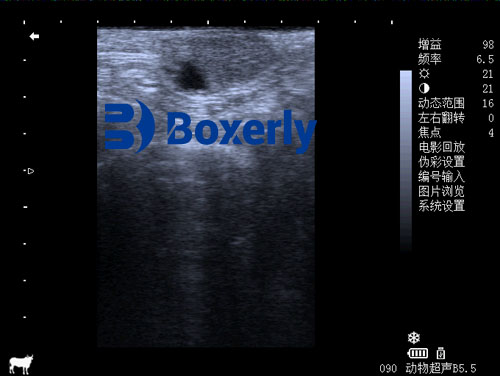Understanding a cow’s reproductive status is crucial to managing herd productivity, optimizing breeding schedules, and reducing open days. Ultrasound examination is one of the most effective tools for early and accurate pregnancy detection in cattle, and it is widely adopted in modern livestock management.
في هذه المقالة, we’ll break down how to perform pregnancy diagnosis in cows using ultrasound, explain when and why to use it, and share practical tips to improve accuracy and animal welfare.
Why Use Ultrasound for Bovine Pregnancy Diagnosis?
Ultrasound (ultrasonography) is a non-invasive, real-time imaging technique that allows farmers or veterinarians to visualize the reproductive tract of the cow. Compared to traditional methods such as rectal palpation, ultrasound provides:
-
Earlier detection (as early as 26–30 days post-breeding)
-
Accurate fetal aging
-
Identification of twin pregnancies
-
Better evaluation of uterine health
-
Safer handling for both cow and operator
When to Perform the Ultrasound Exam?
The ideal time for pregnancy detection using ultrasound is between 28 و 60 days after insemination. Earlier exams (before 26 أيام) may yield false negatives due to limited fetal development, while later exams miss the opportunity for early culling or rebreeding.
It is advisable to confirm negative results at least 10–14 days later if the cow still doesn’t return to estrus.
Basic Equipment Needed
To perform an ultrasound on cattle, you’ll need:
-
A veterinary-grade ultrasound machine (portable and preferably battery-powered for field use)
-
A linear or convex rectal probe (5.0–7.5 MHz)
-
Disposable sleeves and lubricant
-
Access to good cattle restraint equipment (chutes, head gates)

Step-by-Step Guide to Ultrasounding a Cow for Pregnancy
-
Restrain the Animal
Proper restraint is critical for safety. Use a chute or squeeze gate to immobilize the cow. Make sure the animal is calm to avoid injuries. -
Prepare the Equipment
Ensure your ultrasound machine is fully charged, and the probe is clean. Apply ultrasound gel or lubricant to the probe to improve image clarity. -
Insertion and Scanning
With a gloved and lubricated hand, insert the ultrasound probe rectally. Carefully navigate toward the uterus. Scan the uterus and look for signs of pregnancy:
-
A fluid-filled uterine horn indicates early pregnancy
-
Visualization of the embryo or fetus confirms viability
-
Fetal heartbeat indicates a live pregnancy
-
Interpreting the Image
With practice, you’ll be able to detect fetal size, heartbeat, cotyledons (placental structures), and sometimes the number of fetuses. Measurements such as crown-rump length can help estimate gestational age.

-
Recording and Management
Document pregnancy status, estimated fetal age, and any abnormalities. Use this information for herd reproductive management decisions.
Challenges and Troubleshooting
-
False negatives: May occur if scanning too early or misidentifying structures. Re-scan in 10–14 days.
-
Misidentification of twins: Early-stage twins may be missed if located close together.
-
Operator skill: Ultrasound requires training. Regular practice improves detection accuracy.
-
Dirty or poor-quality images: Ensure probe hygiene and good contact with the rectal wall.
Tips to Improve Success
-
Avoid scanning cows less than 26 days post-breeding.
-
Clean the rectum to improve image quality.
-
Keep equipment warm in cold weather to maintain performance.
-
Use scanning as part of a herd reproductive protocol, not a one-off event.
Animal Welfare Considerations
Ultrasound is generally well-tolerated by cows when performed correctly. Minimize stress through gentle handling, short restraint time, and proper technique. Never use excessive force during rectal scanning.
Alternatives to Ultrasound
Other methods like rectal palpation, blood tests (PAGs or PSPB-based), and milk progesterone analysis exist. لكن, ultrasound is more versatile for determining fetal age and viability and identifying twins or uterine pathologies.
استنتاج
Ultrasound is a powerful tool for cattle farmers aiming to improve reproductive efficiency. When used properly, it provides early, accurate, and actionable information that can guide herd management decisions and reduce economic losses due to open cows.
References (Verified Sources)
-
“Pregnancy Diagnosis in Cattle,” University of Wisconsin-Madison Extension
https://livestock.extension.wisc.edu/articles/pregnancy-diagnosis-in-cattle/ -
“Reproductive Ultrasound in Cattle,” University of Missouri Extension
https://extension.missouri.edu/publications/g2041 -
“How and When to Check for Pregnancy in Cows,” Beef Cattle Research Council
https://www.beefresearch.ca/blog/how-and-when-to-check-for-pregnancy-in-cows/ -
“Ultrasound Pregnancy Diagnosis in Cattle,” The Cattle Site
https://www.thecattlesite.com/articles/ultrasound-pregnancy-diagnosis-in-cattle/